Implementing and Monitoring Care for Older People: Short Answers
VerifiedAdded on 2023/01/05
|17
|5260
|53
Homework Assignment
AI Summary
This document provides a detailed analysis of the care of older people, addressing various aspects of geriatric care. It covers potential impacts of multiple diagnoses, the purpose of counseling and support services, and the roles of bereavement counselors and the Older Persons Mental Health Service (OPMHS). The document differentiates between end-of-life and palliative care, discusses limitations and legal ramifications of physical, chemical, and psychological restraints, and explores legal aspects like advance care directives, the Aged Care Act, and the Carers Recognition Act. It also examines the role of primary health care services, physical triggers of behavior, the prevalence of cancer, complementary therapies, and management of challenging behaviors and incontinence. Further, it provides insights into key considerations after a person's death, oral hygiene care, and functional assessment tools.
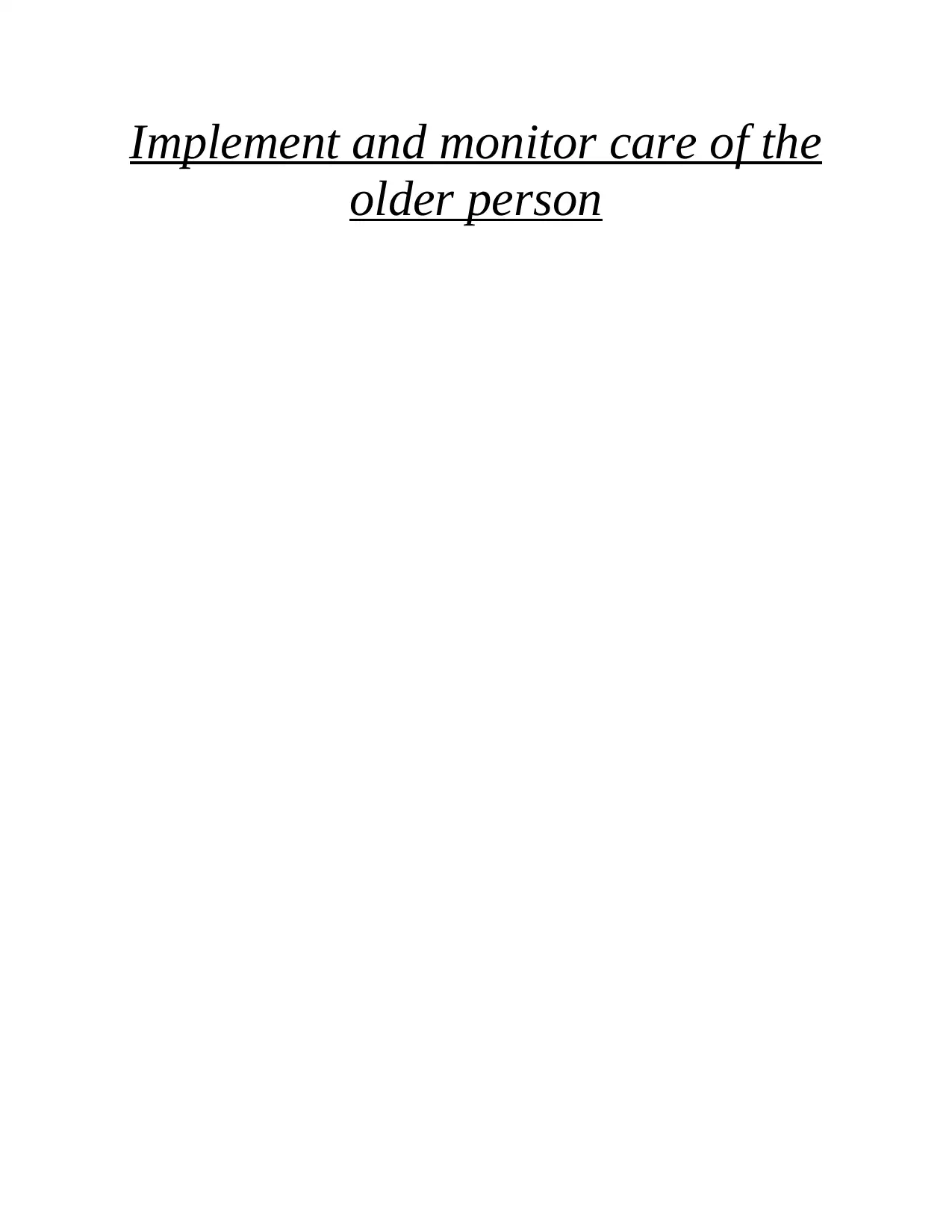
Implement and monitor care of the
older person
older person
Paraphrase This Document
Need a fresh take? Get an instant paraphrase of this document with our AI Paraphraser

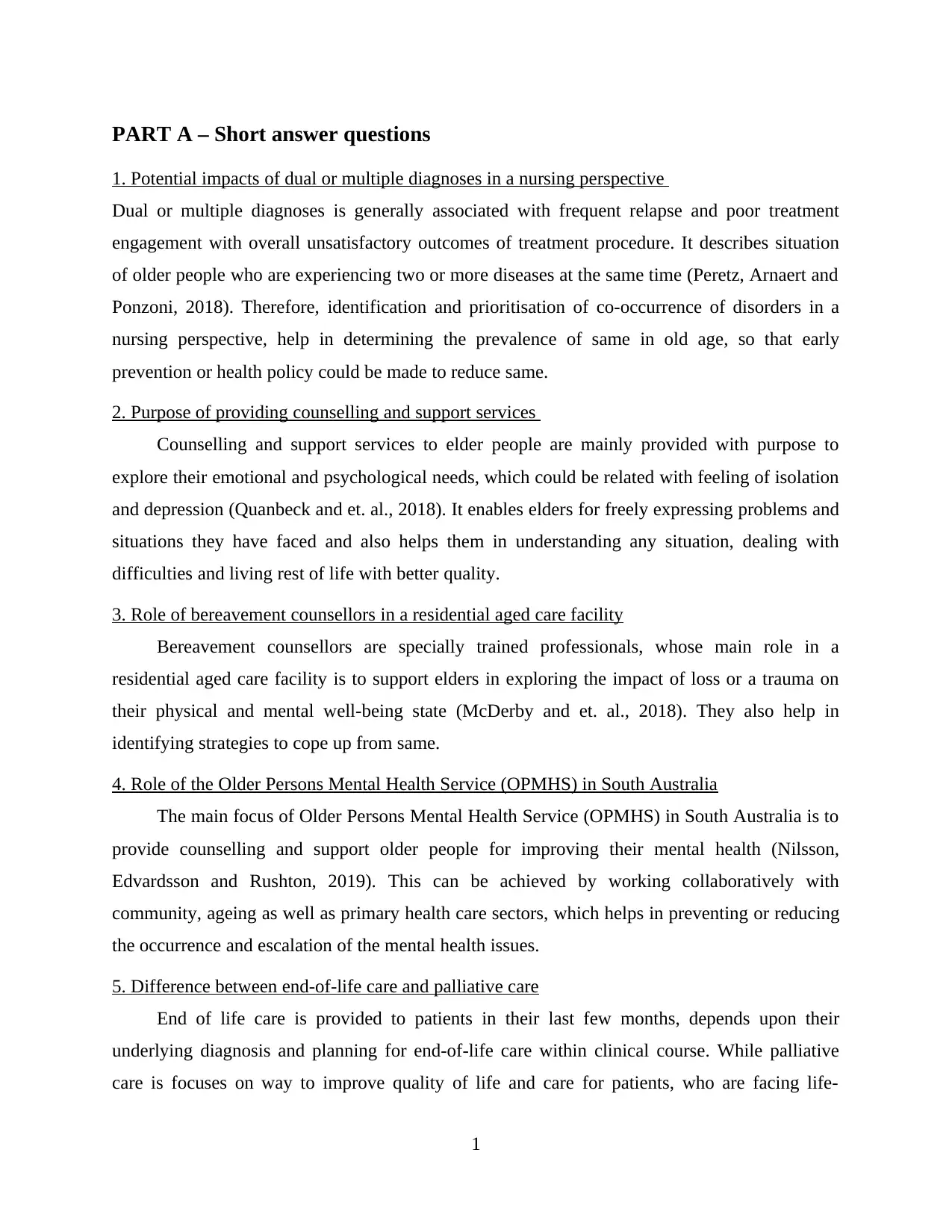
PART A – Short answer questions
1. Potential impacts of dual or multiple diagnoses in a nursing perspective
Dual or multiple diagnoses is generally associated with frequent relapse and poor treatment
engagement with overall unsatisfactory outcomes of treatment procedure. It describes situation
of older people who are experiencing two or more diseases at the same time (Peretz, Arnaert and
Ponzoni, 2018). Therefore, identification and prioritisation of co-occurrence of disorders in a
nursing perspective, help in determining the prevalence of same in old age, so that early
prevention or health policy could be made to reduce same.
2. Purpose of providing counselling and support services
Counselling and support services to elder people are mainly provided with purpose to
explore their emotional and psychological needs, which could be related with feeling of isolation
and depression (Quanbeck and et. al., 2018). It enables elders for freely expressing problems and
situations they have faced and also helps them in understanding any situation, dealing with
difficulties and living rest of life with better quality.
3. Role of bereavement counsellors in a residential aged care facility
Bereavement counsellors are specially trained professionals, whose main role in a
residential aged care facility is to support elders in exploring the impact of loss or a trauma on
their physical and mental well-being state (McDerby and et. al., 2018). They also help in
identifying strategies to cope up from same.
4. Role of the Older Persons Mental Health Service (OPMHS) in South Australia
The main focus of Older Persons Mental Health Service (OPMHS) in South Australia is to
provide counselling and support older people for improving their mental health (Nilsson,
Edvardsson and Rushton, 2019). This can be achieved by working collaboratively with
community, ageing as well as primary health care sectors, which helps in preventing or reducing
the occurrence and escalation of the mental health issues.
5. Difference between end-of-life care and palliative care
End of life care is provided to patients in their last few months, depends upon their
underlying diagnosis and planning for end-of-life care within clinical course. While palliative
care is focuses on way to improve quality of life and care for patients, who are facing life-
1
1. Potential impacts of dual or multiple diagnoses in a nursing perspective
Dual or multiple diagnoses is generally associated with frequent relapse and poor treatment
engagement with overall unsatisfactory outcomes of treatment procedure. It describes situation
of older people who are experiencing two or more diseases at the same time (Peretz, Arnaert and
Ponzoni, 2018). Therefore, identification and prioritisation of co-occurrence of disorders in a
nursing perspective, help in determining the prevalence of same in old age, so that early
prevention or health policy could be made to reduce same.
2. Purpose of providing counselling and support services
Counselling and support services to elder people are mainly provided with purpose to
explore their emotional and psychological needs, which could be related with feeling of isolation
and depression (Quanbeck and et. al., 2018). It enables elders for freely expressing problems and
situations they have faced and also helps them in understanding any situation, dealing with
difficulties and living rest of life with better quality.
3. Role of bereavement counsellors in a residential aged care facility
Bereavement counsellors are specially trained professionals, whose main role in a
residential aged care facility is to support elders in exploring the impact of loss or a trauma on
their physical and mental well-being state (McDerby and et. al., 2018). They also help in
identifying strategies to cope up from same.
4. Role of the Older Persons Mental Health Service (OPMHS) in South Australia
The main focus of Older Persons Mental Health Service (OPMHS) in South Australia is to
provide counselling and support older people for improving their mental health (Nilsson,
Edvardsson and Rushton, 2019). This can be achieved by working collaboratively with
community, ageing as well as primary health care sectors, which helps in preventing or reducing
the occurrence and escalation of the mental health issues.
5. Difference between end-of-life care and palliative care
End of life care is provided to patients in their last few months, depends upon their
underlying diagnosis and planning for end-of-life care within clinical course. While palliative
care is focuses on way to improve quality of life and care for patients, who are facing life-
1
⊘ This is a preview!⊘
Do you want full access?
Subscribe today to unlock all pages.

Trusted by 1+ million students worldwide
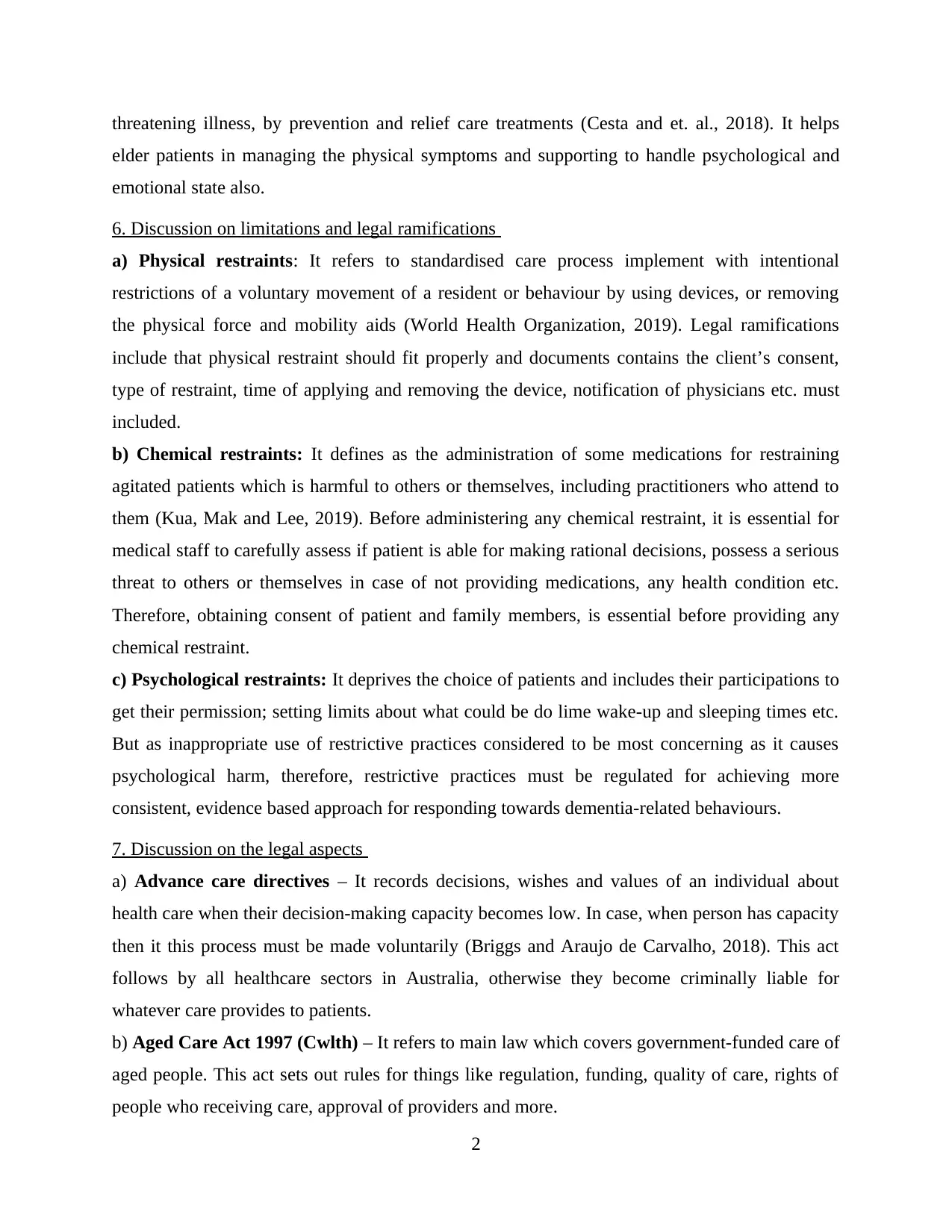
threatening illness, by prevention and relief care treatments (Cesta and et. al., 2018). It helps
elder patients in managing the physical symptoms and supporting to handle psychological and
emotional state also.
6. Discussion on limitations and legal ramifications
a) Physical restraints: It refers to standardised care process implement with intentional
restrictions of a voluntary movement of a resident or behaviour by using devices, or removing
the physical force and mobility aids (World Health Organization, 2019). Legal ramifications
include that physical restraint should fit properly and documents contains the client’s consent,
type of restraint, time of applying and removing the device, notification of physicians etc. must
included.
b) Chemical restraints: It defines as the administration of some medications for restraining
agitated patients which is harmful to others or themselves, including practitioners who attend to
them (Kua, Mak and Lee, 2019). Before administering any chemical restraint, it is essential for
medical staff to carefully assess if patient is able for making rational decisions, possess a serious
threat to others or themselves in case of not providing medications, any health condition etc.
Therefore, obtaining consent of patient and family members, is essential before providing any
chemical restraint.
c) Psychological restraints: It deprives the choice of patients and includes their participations to
get their permission; setting limits about what could be do lime wake-up and sleeping times etc.
But as inappropriate use of restrictive practices considered to be most concerning as it causes
psychological harm, therefore, restrictive practices must be regulated for achieving more
consistent, evidence based approach for responding towards dementia-related behaviours.
7. Discussion on the legal aspects
a) Advance care directives – It records decisions, wishes and values of an individual about
health care when their decision-making capacity becomes low. In case, when person has capacity
then it this process must be made voluntarily (Briggs and Araujo de Carvalho, 2018). This act
follows by all healthcare sectors in Australia, otherwise they become criminally liable for
whatever care provides to patients.
b) Aged Care Act 1997 (Cwlth) – It refers to main law which covers government-funded care of
aged people. This act sets out rules for things like regulation, funding, quality of care, rights of
people who receiving care, approval of providers and more.
2
elder patients in managing the physical symptoms and supporting to handle psychological and
emotional state also.
6. Discussion on limitations and legal ramifications
a) Physical restraints: It refers to standardised care process implement with intentional
restrictions of a voluntary movement of a resident or behaviour by using devices, or removing
the physical force and mobility aids (World Health Organization, 2019). Legal ramifications
include that physical restraint should fit properly and documents contains the client’s consent,
type of restraint, time of applying and removing the device, notification of physicians etc. must
included.
b) Chemical restraints: It defines as the administration of some medications for restraining
agitated patients which is harmful to others or themselves, including practitioners who attend to
them (Kua, Mak and Lee, 2019). Before administering any chemical restraint, it is essential for
medical staff to carefully assess if patient is able for making rational decisions, possess a serious
threat to others or themselves in case of not providing medications, any health condition etc.
Therefore, obtaining consent of patient and family members, is essential before providing any
chemical restraint.
c) Psychological restraints: It deprives the choice of patients and includes their participations to
get their permission; setting limits about what could be do lime wake-up and sleeping times etc.
But as inappropriate use of restrictive practices considered to be most concerning as it causes
psychological harm, therefore, restrictive practices must be regulated for achieving more
consistent, evidence based approach for responding towards dementia-related behaviours.
7. Discussion on the legal aspects
a) Advance care directives – It records decisions, wishes and values of an individual about
health care when their decision-making capacity becomes low. In case, when person has capacity
then it this process must be made voluntarily (Briggs and Araujo de Carvalho, 2018). This act
follows by all healthcare sectors in Australia, otherwise they become criminally liable for
whatever care provides to patients.
b) Aged Care Act 1997 (Cwlth) – It refers to main law which covers government-funded care of
aged people. This act sets out rules for things like regulation, funding, quality of care, rights of
people who receiving care, approval of providers and more.
2
Paraphrase This Document
Need a fresh take? Get an instant paraphrase of this document with our AI Paraphraser
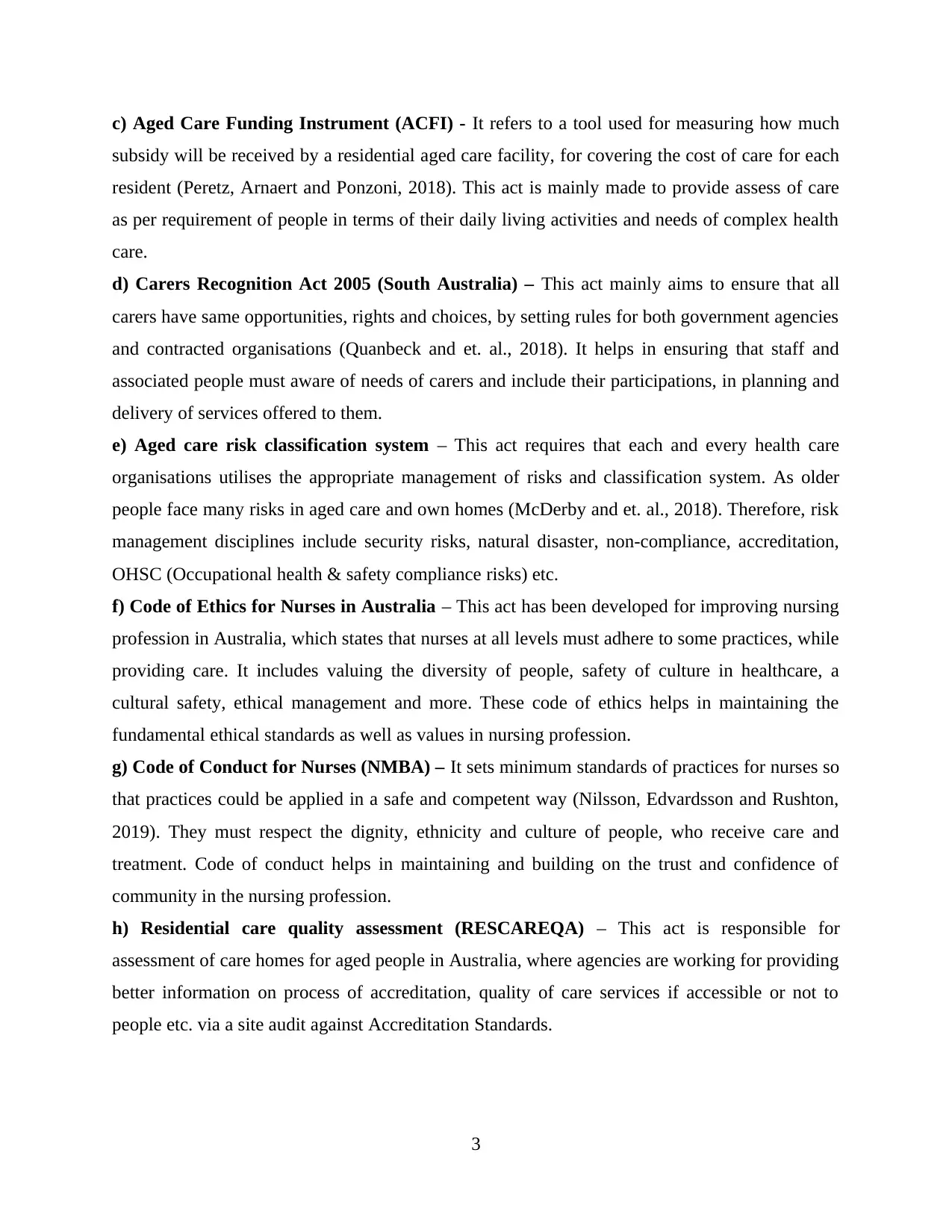
c) Aged Care Funding Instrument (ACFI) - It refers to a tool used for measuring how much
subsidy will be received by a residential aged care facility, for covering the cost of care for each
resident (Peretz, Arnaert and Ponzoni, 2018). This act is mainly made to provide assess of care
as per requirement of people in terms of their daily living activities and needs of complex health
care.
d) Carers Recognition Act 2005 (South Australia) – This act mainly aims to ensure that all
carers have same opportunities, rights and choices, by setting rules for both government agencies
and contracted organisations (Quanbeck and et. al., 2018). It helps in ensuring that staff and
associated people must aware of needs of carers and include their participations, in planning and
delivery of services offered to them.
e) Aged care risk classification system – This act requires that each and every health care
organisations utilises the appropriate management of risks and classification system. As older
people face many risks in aged care and own homes (McDerby and et. al., 2018). Therefore, risk
management disciplines include security risks, natural disaster, non-compliance, accreditation,
OHSC (Occupational health & safety compliance risks) etc.
f) Code of Ethics for Nurses in Australia – This act has been developed for improving nursing
profession in Australia, which states that nurses at all levels must adhere to some practices, while
providing care. It includes valuing the diversity of people, safety of culture in healthcare, a
cultural safety, ethical management and more. These code of ethics helps in maintaining the
fundamental ethical standards as well as values in nursing profession.
g) Code of Conduct for Nurses (NMBA) – It sets minimum standards of practices for nurses so
that practices could be applied in a safe and competent way (Nilsson, Edvardsson and Rushton,
2019). They must respect the dignity, ethnicity and culture of people, who receive care and
treatment. Code of conduct helps in maintaining and building on the trust and confidence of
community in the nursing profession.
h) Residential care quality assessment (RESCAREQA) – This act is responsible for
assessment of care homes for aged people in Australia, where agencies are working for providing
better information on process of accreditation, quality of care services if accessible or not to
people etc. via a site audit against Accreditation Standards.
3
subsidy will be received by a residential aged care facility, for covering the cost of care for each
resident (Peretz, Arnaert and Ponzoni, 2018). This act is mainly made to provide assess of care
as per requirement of people in terms of their daily living activities and needs of complex health
care.
d) Carers Recognition Act 2005 (South Australia) – This act mainly aims to ensure that all
carers have same opportunities, rights and choices, by setting rules for both government agencies
and contracted organisations (Quanbeck and et. al., 2018). It helps in ensuring that staff and
associated people must aware of needs of carers and include their participations, in planning and
delivery of services offered to them.
e) Aged care risk classification system – This act requires that each and every health care
organisations utilises the appropriate management of risks and classification system. As older
people face many risks in aged care and own homes (McDerby and et. al., 2018). Therefore, risk
management disciplines include security risks, natural disaster, non-compliance, accreditation,
OHSC (Occupational health & safety compliance risks) etc.
f) Code of Ethics for Nurses in Australia – This act has been developed for improving nursing
profession in Australia, which states that nurses at all levels must adhere to some practices, while
providing care. It includes valuing the diversity of people, safety of culture in healthcare, a
cultural safety, ethical management and more. These code of ethics helps in maintaining the
fundamental ethical standards as well as values in nursing profession.
g) Code of Conduct for Nurses (NMBA) – It sets minimum standards of practices for nurses so
that practices could be applied in a safe and competent way (Nilsson, Edvardsson and Rushton,
2019). They must respect the dignity, ethnicity and culture of people, who receive care and
treatment. Code of conduct helps in maintaining and building on the trust and confidence of
community in the nursing profession.
h) Residential care quality assessment (RESCAREQA) – This act is responsible for
assessment of care homes for aged people in Australia, where agencies are working for providing
better information on process of accreditation, quality of care services if accessible or not to
people etc. via a site audit against Accreditation Standards.
3
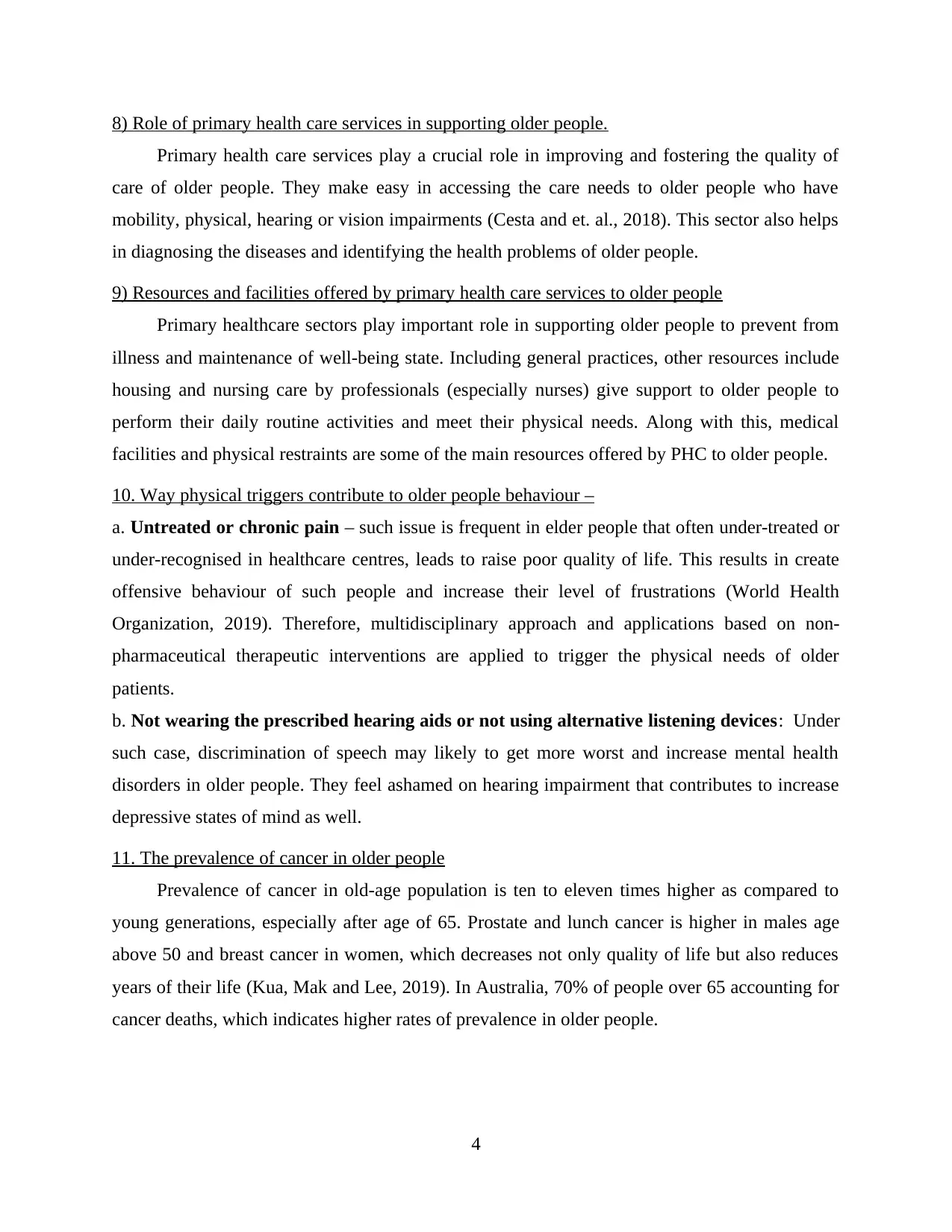
8) Role of primary health care services in supporting older people.
Primary health care services play a crucial role in improving and fostering the quality of
care of older people. They make easy in accessing the care needs to older people who have
mobility, physical, hearing or vision impairments (Cesta and et. al., 2018). This sector also helps
in diagnosing the diseases and identifying the health problems of older people.
9) Resources and facilities offered by primary health care services to older people
Primary healthcare sectors play important role in supporting older people to prevent from
illness and maintenance of well-being state. Including general practices, other resources include
housing and nursing care by professionals (especially nurses) give support to older people to
perform their daily routine activities and meet their physical needs. Along with this, medical
facilities and physical restraints are some of the main resources offered by PHC to older people.
10. Way physical triggers contribute to older people behaviour –
a. Untreated or chronic pain – such issue is frequent in elder people that often under-treated or
under-recognised in healthcare centres, leads to raise poor quality of life. This results in create
offensive behaviour of such people and increase their level of frustrations (World Health
Organization, 2019). Therefore, multidisciplinary approach and applications based on non-
pharmaceutical therapeutic interventions are applied to trigger the physical needs of older
patients.
b. Not wearing the prescribed hearing aids or not using alternative listening devices: Under
such case, discrimination of speech may likely to get more worst and increase mental health
disorders in older people. They feel ashamed on hearing impairment that contributes to increase
depressive states of mind as well.
11. The prevalence of cancer in older people
Prevalence of cancer in old-age population is ten to eleven times higher as compared to
young generations, especially after age of 65. Prostate and lunch cancer is higher in males age
above 50 and breast cancer in women, which decreases not only quality of life but also reduces
years of their life (Kua, Mak and Lee, 2019). In Australia, 70% of people over 65 accounting for
cancer deaths, which indicates higher rates of prevalence in older people.
4
Primary health care services play a crucial role in improving and fostering the quality of
care of older people. They make easy in accessing the care needs to older people who have
mobility, physical, hearing or vision impairments (Cesta and et. al., 2018). This sector also helps
in diagnosing the diseases and identifying the health problems of older people.
9) Resources and facilities offered by primary health care services to older people
Primary healthcare sectors play important role in supporting older people to prevent from
illness and maintenance of well-being state. Including general practices, other resources include
housing and nursing care by professionals (especially nurses) give support to older people to
perform their daily routine activities and meet their physical needs. Along with this, medical
facilities and physical restraints are some of the main resources offered by PHC to older people.
10. Way physical triggers contribute to older people behaviour –
a. Untreated or chronic pain – such issue is frequent in elder people that often under-treated or
under-recognised in healthcare centres, leads to raise poor quality of life. This results in create
offensive behaviour of such people and increase their level of frustrations (World Health
Organization, 2019). Therefore, multidisciplinary approach and applications based on non-
pharmaceutical therapeutic interventions are applied to trigger the physical needs of older
patients.
b. Not wearing the prescribed hearing aids or not using alternative listening devices: Under
such case, discrimination of speech may likely to get more worst and increase mental health
disorders in older people. They feel ashamed on hearing impairment that contributes to increase
depressive states of mind as well.
11. The prevalence of cancer in older people
Prevalence of cancer in old-age population is ten to eleven times higher as compared to
young generations, especially after age of 65. Prostate and lunch cancer is higher in males age
above 50 and breast cancer in women, which decreases not only quality of life but also reduces
years of their life (Kua, Mak and Lee, 2019). In Australia, 70% of people over 65 accounting for
cancer deaths, which indicates higher rates of prevalence in older people.
4
⊘ This is a preview!⊘
Do you want full access?
Subscribe today to unlock all pages.

Trusted by 1+ million students worldwide
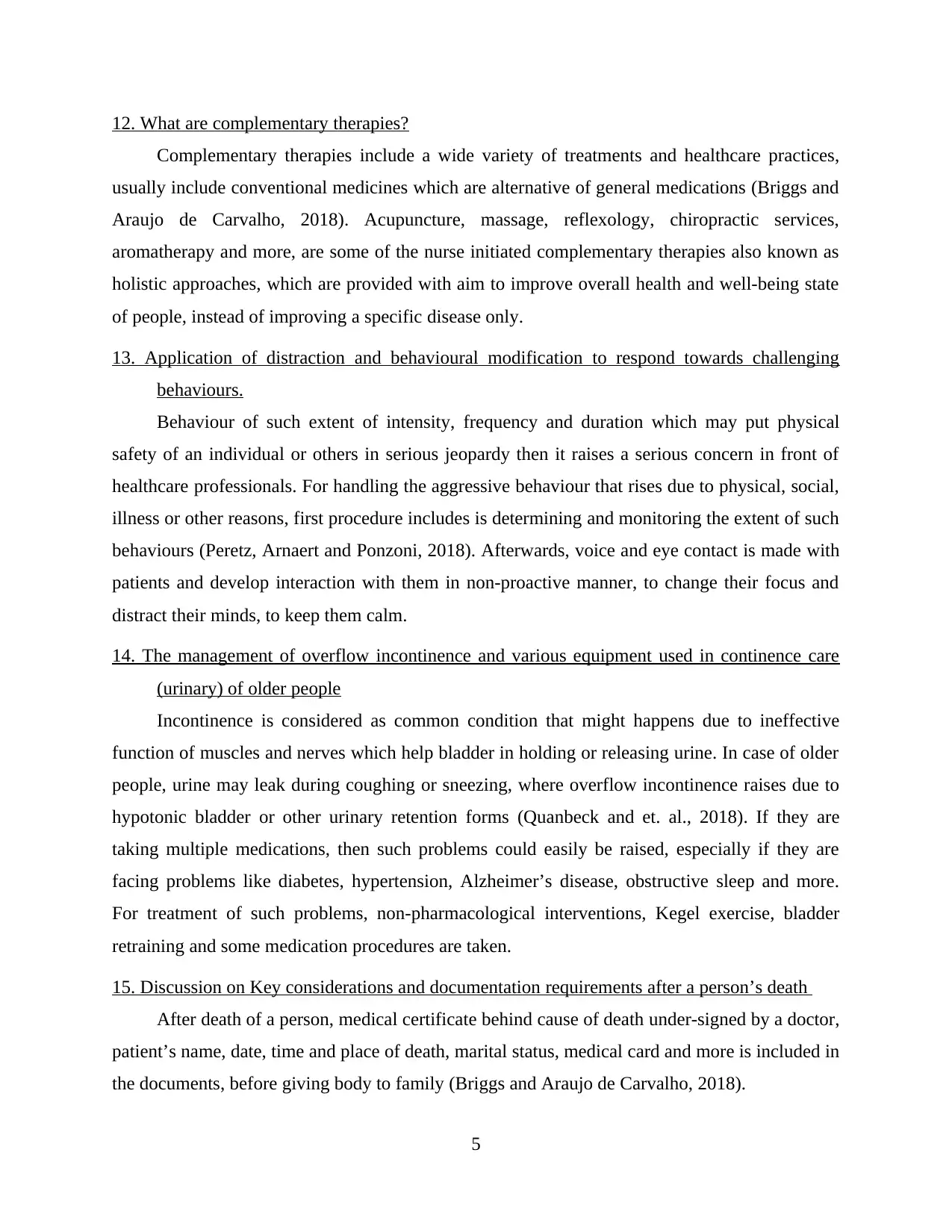
12. What are complementary therapies?
Complementary therapies include a wide variety of treatments and healthcare practices,
usually include conventional medicines which are alternative of general medications (Briggs and
Araujo de Carvalho, 2018). Acupuncture, massage, reflexology, chiropractic services,
aromatherapy and more, are some of the nurse initiated complementary therapies also known as
holistic approaches, which are provided with aim to improve overall health and well-being state
of people, instead of improving a specific disease only.
13. Application of distraction and behavioural modification to respond towards challenging
behaviours.
Behaviour of such extent of intensity, frequency and duration which may put physical
safety of an individual or others in serious jeopardy then it raises a serious concern in front of
healthcare professionals. For handling the aggressive behaviour that rises due to physical, social,
illness or other reasons, first procedure includes is determining and monitoring the extent of such
behaviours (Peretz, Arnaert and Ponzoni, 2018). Afterwards, voice and eye contact is made with
patients and develop interaction with them in non-proactive manner, to change their focus and
distract their minds, to keep them calm.
14. The management of overflow incontinence and various equipment used in continence care
(urinary) of older people
Incontinence is considered as common condition that might happens due to ineffective
function of muscles and nerves which help bladder in holding or releasing urine. In case of older
people, urine may leak during coughing or sneezing, where overflow incontinence raises due to
hypotonic bladder or other urinary retention forms (Quanbeck and et. al., 2018). If they are
taking multiple medications, then such problems could easily be raised, especially if they are
facing problems like diabetes, hypertension, Alzheimer’s disease, obstructive sleep and more.
For treatment of such problems, non-pharmacological interventions, Kegel exercise, bladder
retraining and some medication procedures are taken.
15. Discussion on Key considerations and documentation requirements after a person’s death
After death of a person, medical certificate behind cause of death under-signed by a doctor,
patient’s name, date, time and place of death, marital status, medical card and more is included in
the documents, before giving body to family (Briggs and Araujo de Carvalho, 2018).
5
Complementary therapies include a wide variety of treatments and healthcare practices,
usually include conventional medicines which are alternative of general medications (Briggs and
Araujo de Carvalho, 2018). Acupuncture, massage, reflexology, chiropractic services,
aromatherapy and more, are some of the nurse initiated complementary therapies also known as
holistic approaches, which are provided with aim to improve overall health and well-being state
of people, instead of improving a specific disease only.
13. Application of distraction and behavioural modification to respond towards challenging
behaviours.
Behaviour of such extent of intensity, frequency and duration which may put physical
safety of an individual or others in serious jeopardy then it raises a serious concern in front of
healthcare professionals. For handling the aggressive behaviour that rises due to physical, social,
illness or other reasons, first procedure includes is determining and monitoring the extent of such
behaviours (Peretz, Arnaert and Ponzoni, 2018). Afterwards, voice and eye contact is made with
patients and develop interaction with them in non-proactive manner, to change their focus and
distract their minds, to keep them calm.
14. The management of overflow incontinence and various equipment used in continence care
(urinary) of older people
Incontinence is considered as common condition that might happens due to ineffective
function of muscles and nerves which help bladder in holding or releasing urine. In case of older
people, urine may leak during coughing or sneezing, where overflow incontinence raises due to
hypotonic bladder or other urinary retention forms (Quanbeck and et. al., 2018). If they are
taking multiple medications, then such problems could easily be raised, especially if they are
facing problems like diabetes, hypertension, Alzheimer’s disease, obstructive sleep and more.
For treatment of such problems, non-pharmacological interventions, Kegel exercise, bladder
retraining and some medication procedures are taken.
15. Discussion on Key considerations and documentation requirements after a person’s death
After death of a person, medical certificate behind cause of death under-signed by a doctor,
patient’s name, date, time and place of death, marital status, medical card and more is included in
the documents, before giving body to family (Briggs and Araujo de Carvalho, 2018).
5
Paraphrase This Document
Need a fresh take? Get an instant paraphrase of this document with our AI Paraphraser
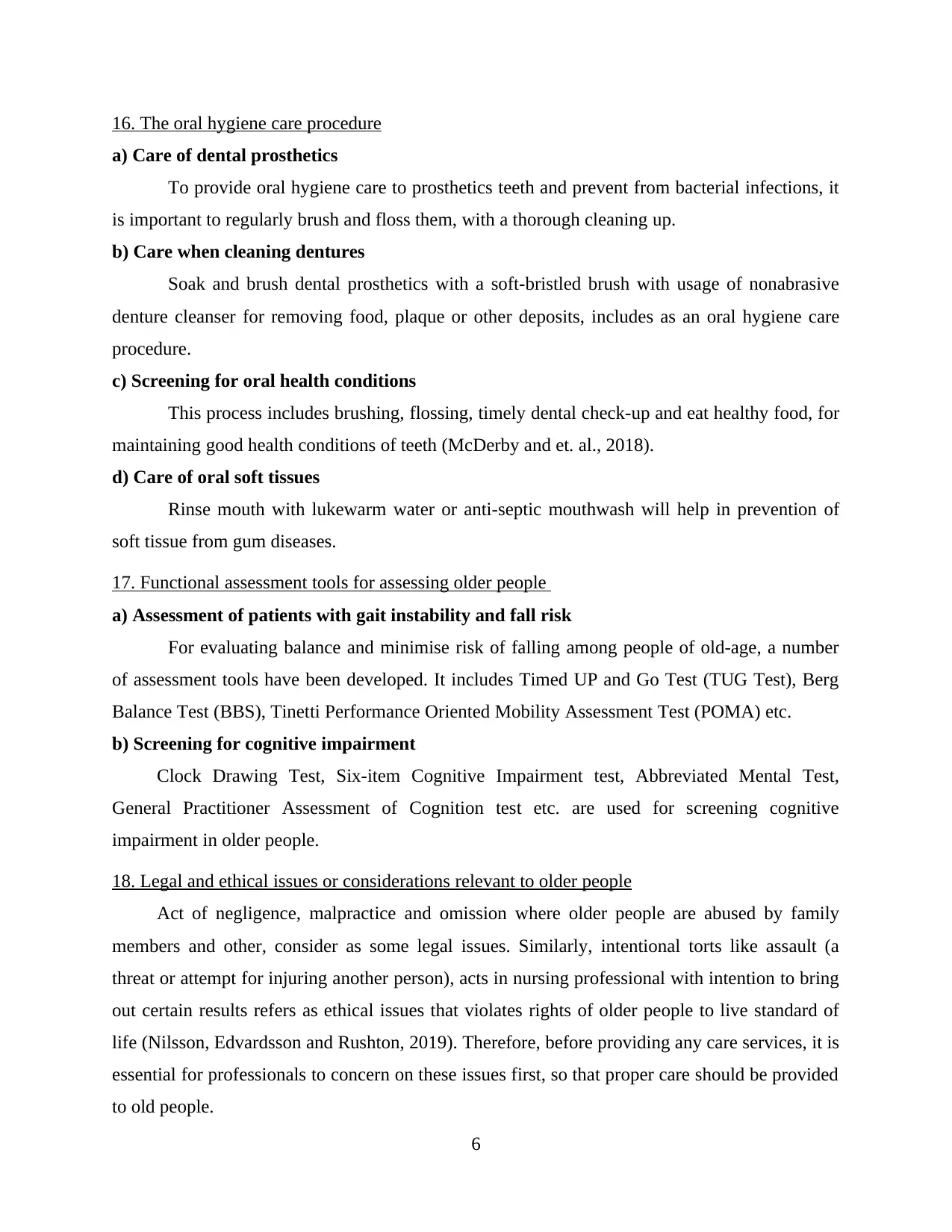
16. The oral hygiene care procedure
a) Care of dental prosthetics
To provide oral hygiene care to prosthetics teeth and prevent from bacterial infections, it
is important to regularly brush and floss them, with a thorough cleaning up.
b) Care when cleaning dentures
Soak and brush dental prosthetics with a soft-bristled brush with usage of nonabrasive
denture cleanser for removing food, plaque or other deposits, includes as an oral hygiene care
procedure.
c) Screening for oral health conditions
This process includes brushing, flossing, timely dental check-up and eat healthy food, for
maintaining good health conditions of teeth (McDerby and et. al., 2018).
d) Care of oral soft tissues
Rinse mouth with lukewarm water or anti-septic mouthwash will help in prevention of
soft tissue from gum diseases.
17. Functional assessment tools for assessing older people
a) Assessment of patients with gait instability and fall risk
For evaluating balance and minimise risk of falling among people of old-age, a number
of assessment tools have been developed. It includes Timed UP and Go Test (TUG Test), Berg
Balance Test (BBS), Tinetti Performance Oriented Mobility Assessment Test (POMA) etc.
b) Screening for cognitive impairment
Clock Drawing Test, Six-item Cognitive Impairment test, Abbreviated Mental Test,
General Practitioner Assessment of Cognition test etc. are used for screening cognitive
impairment in older people.
18. Legal and ethical issues or considerations relevant to older people
Act of negligence, malpractice and omission where older people are abused by family
members and other, consider as some legal issues. Similarly, intentional torts like assault (a
threat or attempt for injuring another person), acts in nursing professional with intention to bring
out certain results refers as ethical issues that violates rights of older people to live standard of
life (Nilsson, Edvardsson and Rushton, 2019). Therefore, before providing any care services, it is
essential for professionals to concern on these issues first, so that proper care should be provided
to old people.
6
a) Care of dental prosthetics
To provide oral hygiene care to prosthetics teeth and prevent from bacterial infections, it
is important to regularly brush and floss them, with a thorough cleaning up.
b) Care when cleaning dentures
Soak and brush dental prosthetics with a soft-bristled brush with usage of nonabrasive
denture cleanser for removing food, plaque or other deposits, includes as an oral hygiene care
procedure.
c) Screening for oral health conditions
This process includes brushing, flossing, timely dental check-up and eat healthy food, for
maintaining good health conditions of teeth (McDerby and et. al., 2018).
d) Care of oral soft tissues
Rinse mouth with lukewarm water or anti-septic mouthwash will help in prevention of
soft tissue from gum diseases.
17. Functional assessment tools for assessing older people
a) Assessment of patients with gait instability and fall risk
For evaluating balance and minimise risk of falling among people of old-age, a number
of assessment tools have been developed. It includes Timed UP and Go Test (TUG Test), Berg
Balance Test (BBS), Tinetti Performance Oriented Mobility Assessment Test (POMA) etc.
b) Screening for cognitive impairment
Clock Drawing Test, Six-item Cognitive Impairment test, Abbreviated Mental Test,
General Practitioner Assessment of Cognition test etc. are used for screening cognitive
impairment in older people.
18. Legal and ethical issues or considerations relevant to older people
Act of negligence, malpractice and omission where older people are abused by family
members and other, consider as some legal issues. Similarly, intentional torts like assault (a
threat or attempt for injuring another person), acts in nursing professional with intention to bring
out certain results refers as ethical issues that violates rights of older people to live standard of
life (Nilsson, Edvardsson and Rushton, 2019). Therefore, before providing any care services, it is
essential for professionals to concern on these issues first, so that proper care should be provided
to old people.
6
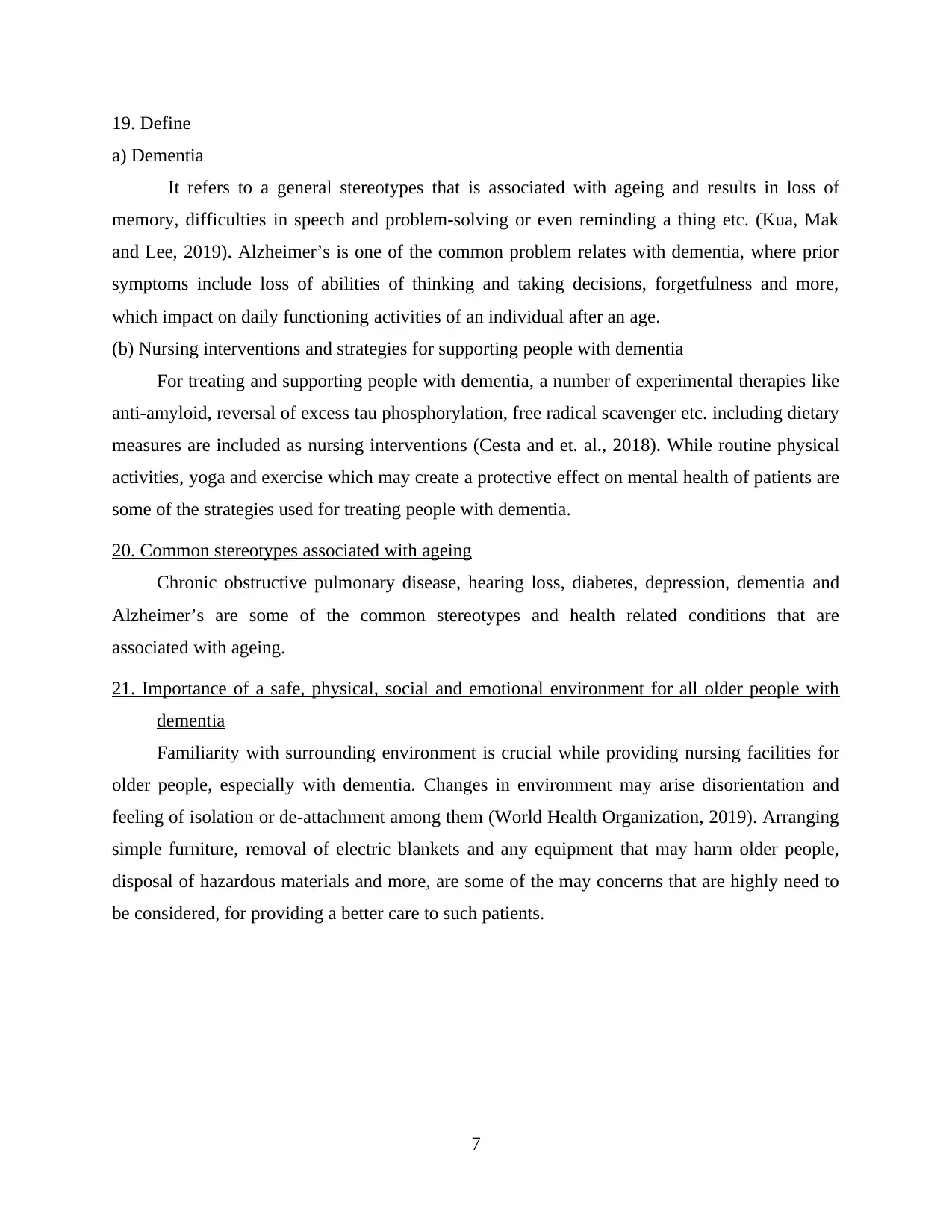
19. Define
a) Dementia
It refers to a general stereotypes that is associated with ageing and results in loss of
memory, difficulties in speech and problem-solving or even reminding a thing etc. (Kua, Mak
and Lee, 2019). Alzheimer’s is one of the common problem relates with dementia, where prior
symptoms include loss of abilities of thinking and taking decisions, forgetfulness and more,
which impact on daily functioning activities of an individual after an age.
(b) Nursing interventions and strategies for supporting people with dementia
For treating and supporting people with dementia, a number of experimental therapies like
anti-amyloid, reversal of excess tau phosphorylation, free radical scavenger etc. including dietary
measures are included as nursing interventions (Cesta and et. al., 2018). While routine physical
activities, yoga and exercise which may create a protective effect on mental health of patients are
some of the strategies used for treating people with dementia.
20. Common stereotypes associated with ageing
Chronic obstructive pulmonary disease, hearing loss, diabetes, depression, dementia and
Alzheimer’s are some of the common stereotypes and health related conditions that are
associated with ageing.
21. Importance of a safe, physical, social and emotional environment for all older people with
dementia
Familiarity with surrounding environment is crucial while providing nursing facilities for
older people, especially with dementia. Changes in environment may arise disorientation and
feeling of isolation or de-attachment among them (World Health Organization, 2019). Arranging
simple furniture, removal of electric blankets and any equipment that may harm older people,
disposal of hazardous materials and more, are some of the may concerns that are highly need to
be considered, for providing a better care to such patients.
7
a) Dementia
It refers to a general stereotypes that is associated with ageing and results in loss of
memory, difficulties in speech and problem-solving or even reminding a thing etc. (Kua, Mak
and Lee, 2019). Alzheimer’s is one of the common problem relates with dementia, where prior
symptoms include loss of abilities of thinking and taking decisions, forgetfulness and more,
which impact on daily functioning activities of an individual after an age.
(b) Nursing interventions and strategies for supporting people with dementia
For treating and supporting people with dementia, a number of experimental therapies like
anti-amyloid, reversal of excess tau phosphorylation, free radical scavenger etc. including dietary
measures are included as nursing interventions (Cesta and et. al., 2018). While routine physical
activities, yoga and exercise which may create a protective effect on mental health of patients are
some of the strategies used for treating people with dementia.
20. Common stereotypes associated with ageing
Chronic obstructive pulmonary disease, hearing loss, diabetes, depression, dementia and
Alzheimer’s are some of the common stereotypes and health related conditions that are
associated with ageing.
21. Importance of a safe, physical, social and emotional environment for all older people with
dementia
Familiarity with surrounding environment is crucial while providing nursing facilities for
older people, especially with dementia. Changes in environment may arise disorientation and
feeling of isolation or de-attachment among them (World Health Organization, 2019). Arranging
simple furniture, removal of electric blankets and any equipment that may harm older people,
disposal of hazardous materials and more, are some of the may concerns that are highly need to
be considered, for providing a better care to such patients.
7
⊘ This is a preview!⊘
Do you want full access?
Subscribe today to unlock all pages.

Trusted by 1+ million students worldwide
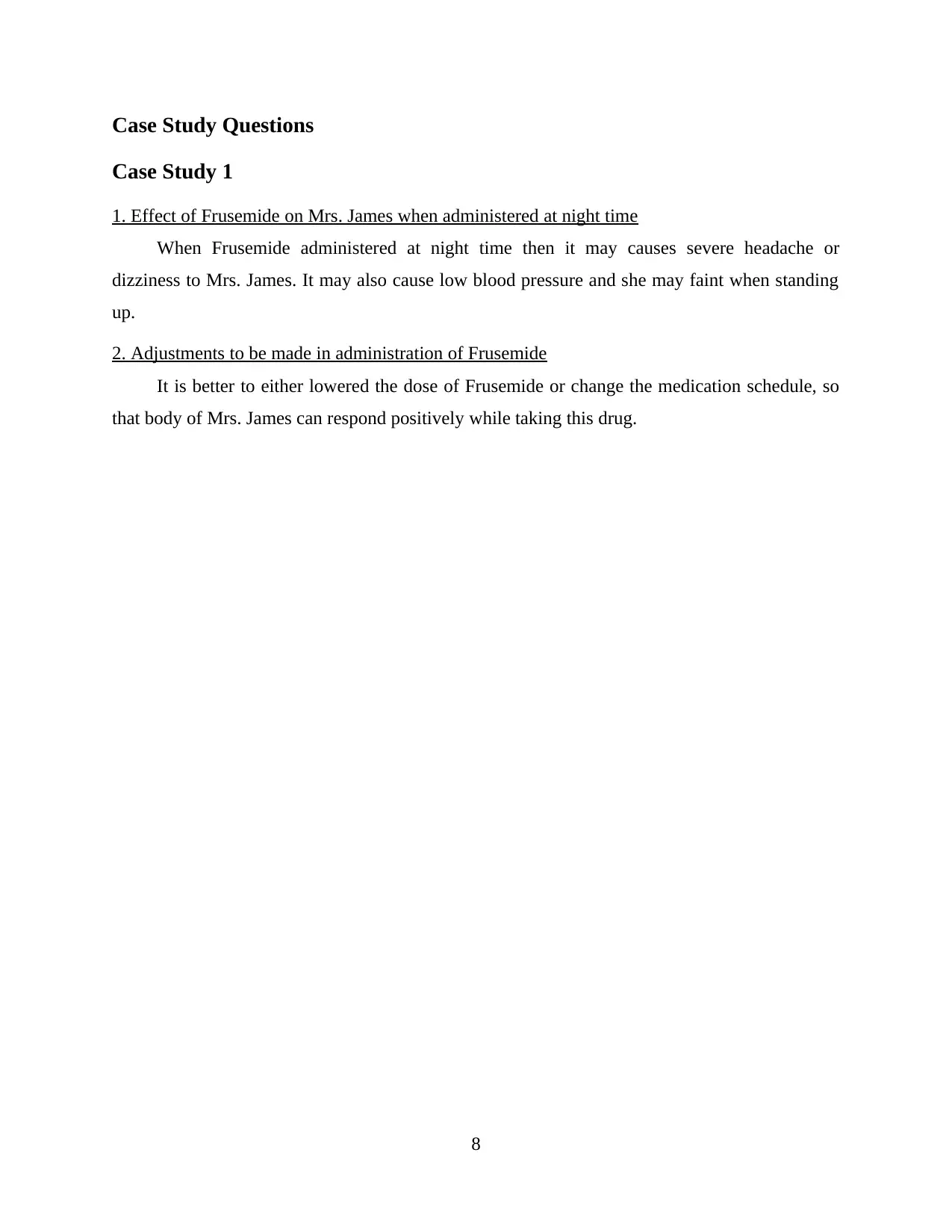
Case Study Questions
Case Study 1
1. Effect of Frusemide on Mrs. James when administered at night time
When Frusemide administered at night time then it may causes severe headache or
dizziness to Mrs. James. It may also cause low blood pressure and she may faint when standing
up.
2. Adjustments to be made in administration of Frusemide
It is better to either lowered the dose of Frusemide or change the medication schedule, so
that body of Mrs. James can respond positively while taking this drug.
8
Case Study 1
1. Effect of Frusemide on Mrs. James when administered at night time
When Frusemide administered at night time then it may causes severe headache or
dizziness to Mrs. James. It may also cause low blood pressure and she may faint when standing
up.
2. Adjustments to be made in administration of Frusemide
It is better to either lowered the dose of Frusemide or change the medication schedule, so
that body of Mrs. James can respond positively while taking this drug.
8
Paraphrase This Document
Need a fresh take? Get an instant paraphrase of this document with our AI Paraphraser
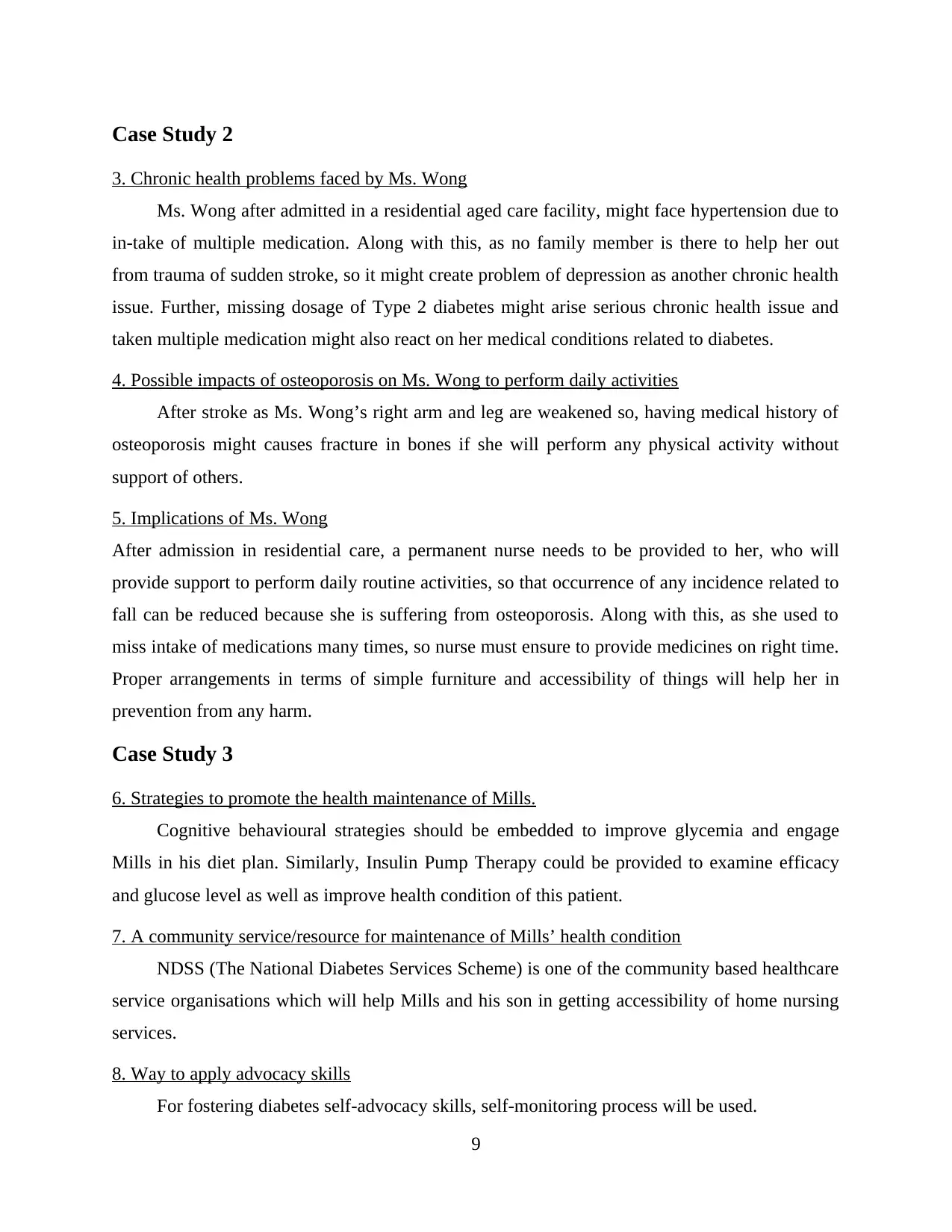
Case Study 2
3. Chronic health problems faced by Ms. Wong
Ms. Wong after admitted in a residential aged care facility, might face hypertension due to
in-take of multiple medication. Along with this, as no family member is there to help her out
from trauma of sudden stroke, so it might create problem of depression as another chronic health
issue. Further, missing dosage of Type 2 diabetes might arise serious chronic health issue and
taken multiple medication might also react on her medical conditions related to diabetes.
4. Possible impacts of osteoporosis on Ms. Wong to perform daily activities
After stroke as Ms. Wong’s right arm and leg are weakened so, having medical history of
osteoporosis might causes fracture in bones if she will perform any physical activity without
support of others.
5. Implications of Ms. Wong
After admission in residential care, a permanent nurse needs to be provided to her, who will
provide support to perform daily routine activities, so that occurrence of any incidence related to
fall can be reduced because she is suffering from osteoporosis. Along with this, as she used to
miss intake of medications many times, so nurse must ensure to provide medicines on right time.
Proper arrangements in terms of simple furniture and accessibility of things will help her in
prevention from any harm.
Case Study 3
6. Strategies to promote the health maintenance of Mills.
Cognitive behavioural strategies should be embedded to improve glycemia and engage
Mills in his diet plan. Similarly, Insulin Pump Therapy could be provided to examine efficacy
and glucose level as well as improve health condition of this patient.
7. A community service/resource for maintenance of Mills’ health condition
NDSS (The National Diabetes Services Scheme) is one of the community based healthcare
service organisations which will help Mills and his son in getting accessibility of home nursing
services.
8. Way to apply advocacy skills
For fostering diabetes self-advocacy skills, self-monitoring process will be used.
9
3. Chronic health problems faced by Ms. Wong
Ms. Wong after admitted in a residential aged care facility, might face hypertension due to
in-take of multiple medication. Along with this, as no family member is there to help her out
from trauma of sudden stroke, so it might create problem of depression as another chronic health
issue. Further, missing dosage of Type 2 diabetes might arise serious chronic health issue and
taken multiple medication might also react on her medical conditions related to diabetes.
4. Possible impacts of osteoporosis on Ms. Wong to perform daily activities
After stroke as Ms. Wong’s right arm and leg are weakened so, having medical history of
osteoporosis might causes fracture in bones if she will perform any physical activity without
support of others.
5. Implications of Ms. Wong
After admission in residential care, a permanent nurse needs to be provided to her, who will
provide support to perform daily routine activities, so that occurrence of any incidence related to
fall can be reduced because she is suffering from osteoporosis. Along with this, as she used to
miss intake of medications many times, so nurse must ensure to provide medicines on right time.
Proper arrangements in terms of simple furniture and accessibility of things will help her in
prevention from any harm.
Case Study 3
6. Strategies to promote the health maintenance of Mills.
Cognitive behavioural strategies should be embedded to improve glycemia and engage
Mills in his diet plan. Similarly, Insulin Pump Therapy could be provided to examine efficacy
and glucose level as well as improve health condition of this patient.
7. A community service/resource for maintenance of Mills’ health condition
NDSS (The National Diabetes Services Scheme) is one of the community based healthcare
service organisations which will help Mills and his son in getting accessibility of home nursing
services.
8. Way to apply advocacy skills
For fostering diabetes self-advocacy skills, self-monitoring process will be used.
9
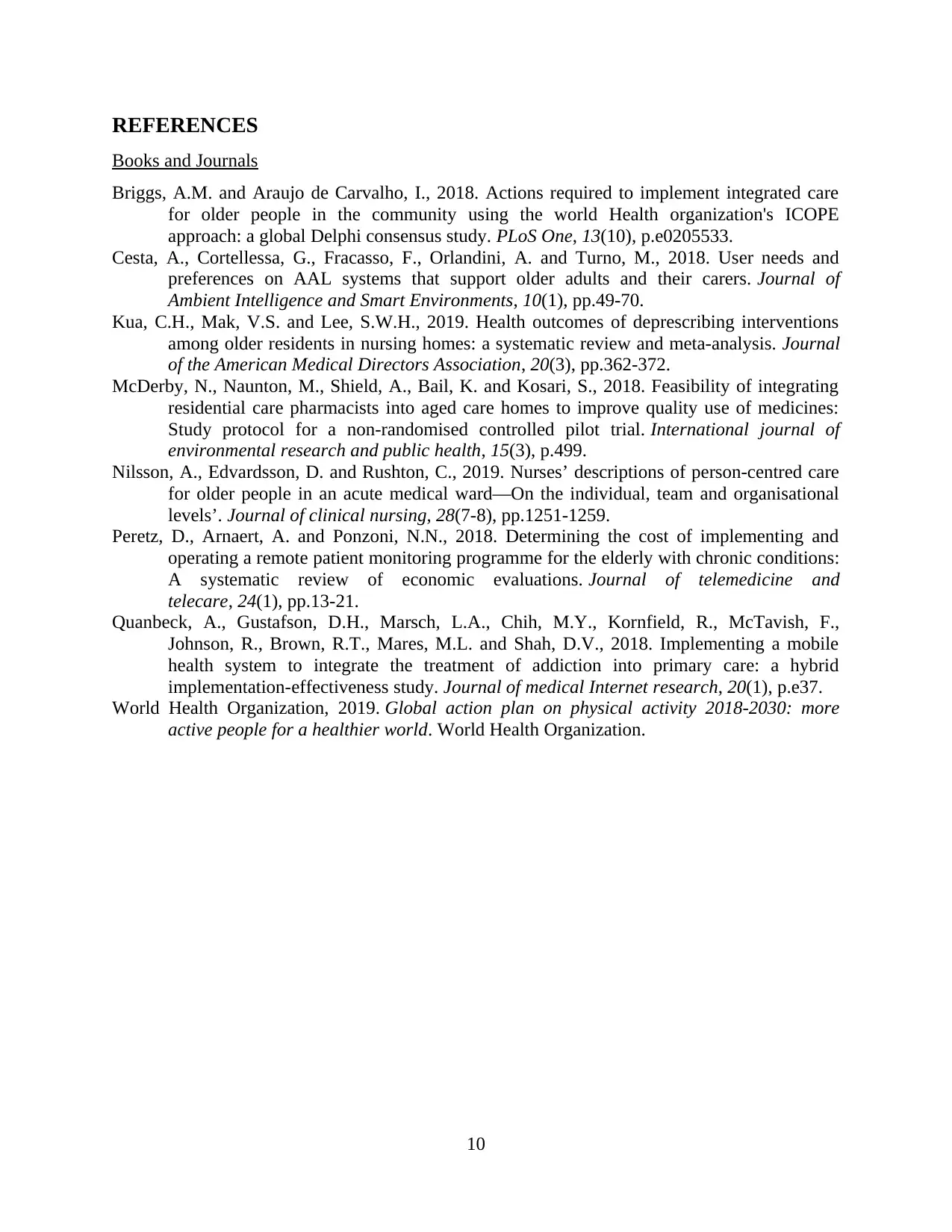
REFERENCES
Books and Journals
Briggs, A.M. and Araujo de Carvalho, I., 2018. Actions required to implement integrated care
for older people in the community using the world Health organization's ICOPE
approach: a global Delphi consensus study. PLoS One, 13(10), p.e0205533.
Cesta, A., Cortellessa, G., Fracasso, F., Orlandini, A. and Turno, M., 2018. User needs and
preferences on AAL systems that support older adults and their carers. Journal of
Ambient Intelligence and Smart Environments, 10(1), pp.49-70.
Kua, C.H., Mak, V.S. and Lee, S.W.H., 2019. Health outcomes of deprescribing interventions
among older residents in nursing homes: a systematic review and meta-analysis. Journal
of the American Medical Directors Association, 20(3), pp.362-372.
McDerby, N., Naunton, M., Shield, A., Bail, K. and Kosari, S., 2018. Feasibility of integrating
residential care pharmacists into aged care homes to improve quality use of medicines:
Study protocol for a non-randomised controlled pilot trial. International journal of
environmental research and public health, 15(3), p.499.
Nilsson, A., Edvardsson, D. and Rushton, C., 2019. Nurses’ descriptions of person‐centred care
for older people in an acute medical ward—On the individual, team and organisational
levels’. Journal of clinical nursing, 28(7-8), pp.1251-1259.
Peretz, D., Arnaert, A. and Ponzoni, N.N., 2018. Determining the cost of implementing and
operating a remote patient monitoring programme for the elderly with chronic conditions:
A systematic review of economic evaluations. Journal of telemedicine and
telecare, 24(1), pp.13-21.
Quanbeck, A., Gustafson, D.H., Marsch, L.A., Chih, M.Y., Kornfield, R., McTavish, F.,
Johnson, R., Brown, R.T., Mares, M.L. and Shah, D.V., 2018. Implementing a mobile
health system to integrate the treatment of addiction into primary care: a hybrid
implementation-effectiveness study. Journal of medical Internet research, 20(1), p.e37.
World Health Organization, 2019. Global action plan on physical activity 2018-2030: more
active people for a healthier world. World Health Organization.
10
Books and Journals
Briggs, A.M. and Araujo de Carvalho, I., 2018. Actions required to implement integrated care
for older people in the community using the world Health organization's ICOPE
approach: a global Delphi consensus study. PLoS One, 13(10), p.e0205533.
Cesta, A., Cortellessa, G., Fracasso, F., Orlandini, A. and Turno, M., 2018. User needs and
preferences on AAL systems that support older adults and their carers. Journal of
Ambient Intelligence and Smart Environments, 10(1), pp.49-70.
Kua, C.H., Mak, V.S. and Lee, S.W.H., 2019. Health outcomes of deprescribing interventions
among older residents in nursing homes: a systematic review and meta-analysis. Journal
of the American Medical Directors Association, 20(3), pp.362-372.
McDerby, N., Naunton, M., Shield, A., Bail, K. and Kosari, S., 2018. Feasibility of integrating
residential care pharmacists into aged care homes to improve quality use of medicines:
Study protocol for a non-randomised controlled pilot trial. International journal of
environmental research and public health, 15(3), p.499.
Nilsson, A., Edvardsson, D. and Rushton, C., 2019. Nurses’ descriptions of person‐centred care
for older people in an acute medical ward—On the individual, team and organisational
levels’. Journal of clinical nursing, 28(7-8), pp.1251-1259.
Peretz, D., Arnaert, A. and Ponzoni, N.N., 2018. Determining the cost of implementing and
operating a remote patient monitoring programme for the elderly with chronic conditions:
A systematic review of economic evaluations. Journal of telemedicine and
telecare, 24(1), pp.13-21.
Quanbeck, A., Gustafson, D.H., Marsch, L.A., Chih, M.Y., Kornfield, R., McTavish, F.,
Johnson, R., Brown, R.T., Mares, M.L. and Shah, D.V., 2018. Implementing a mobile
health system to integrate the treatment of addiction into primary care: a hybrid
implementation-effectiveness study. Journal of medical Internet research, 20(1), p.e37.
World Health Organization, 2019. Global action plan on physical activity 2018-2030: more
active people for a healthier world. World Health Organization.
10
⊘ This is a preview!⊘
Do you want full access?
Subscribe today to unlock all pages.

Trusted by 1+ million students worldwide
1 out of 17
Related Documents
Your All-in-One AI-Powered Toolkit for Academic Success.
+13062052269
info@desklib.com
Available 24*7 on WhatsApp / Email
![[object Object]](/_next/static/media/star-bottom.7253800d.svg)
Unlock your academic potential
Copyright © 2020–2025 A2Z Services. All Rights Reserved. Developed and managed by ZUCOL.





